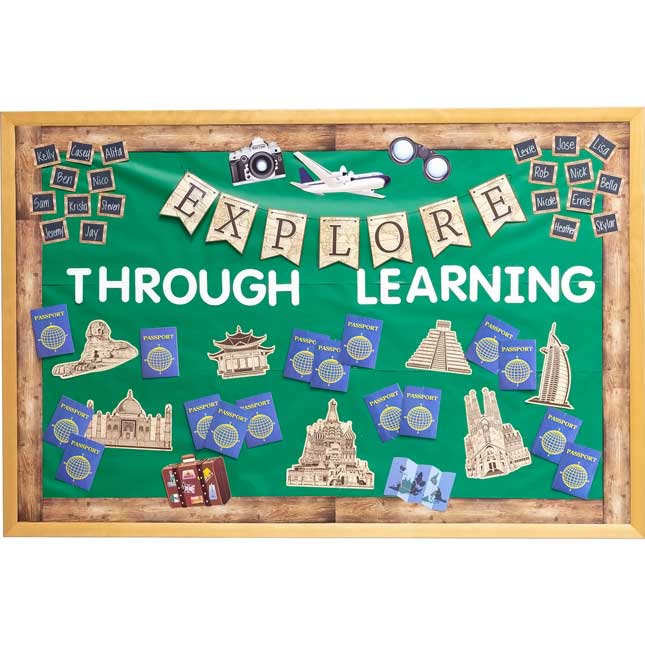Decorating a classroom can transform the learning environment, making it engaging and inspiring for students. One powerful theme that encapsulates diversity and cultural appreciation is “Around the World” classroom decor. In this article, we’ll explore various decorations, activities, and strategies that can help infuse global perspectives into your classroom. Throughout my years as an educator, I’ve found that a well-decorated classroom not only makes learning fun but also fosters a sense of belonging and curiosity among students.
Why Choose an Around-the-World Theme?
Choosing an “Around the World” theme can enrich students’ educational experiences, giving them a glimpse into different cultures, traditions, and lifestyles. Here are some compelling reasons for selecting this theme:
- Promotes Cultural Awareness: Helps students appreciate and understand the differences and similarities across cultures.
- Encourages Curiosity: Sparks interest in geography, history, and social studies.
- Creates a Welcoming Environment: A diverse decor can make all students feel represented and included.
Elements of Around-the-World Classroom Decor
When designing your around-the-world classroom, consider incorporating various elements that represent different continents and cultures. Here’s a list of some essential decor components:
Maps and Globes
Utilizing maps and globes is foundational for any global-themed classroom. They serve as excellent visual aids and conversation starters.
- Use a giant world map as a bulletin board.
- Incorporate globes in different sizes as centerpieces or shelf decorations.

Cultural Artwork
Artwork from various cultures can inspire creativity and appreciation. Consider displaying:
- Posters of famous landmarks from around the world.
- Art pieces created by your students that represent different cultures.
Flags
Hanging flags from different countries around your classroom can create a global atmosphere. This also offers a chance for students to learn about the significance of each flag.

DIY Flag Crafting Activity
A fun classroom activity is to have students create flags representing their heritage. This fosters personal connection and engagement.
Classroom Borders and Accents
Choose border decorations that feature symbols or patterns from various cultures. For example, you might find:
- African tribal patterns
- Asian floral designs
- European architectural motifs

Books and Literature
Include a reading corner with books from different cultures or books that focus on global themes. This can encourage cross-cultural understanding and discussions among students.
Incorporating Interactive Elements

Enhance your classroom with interactive elements that facilitate engagement. Here’s what you can do:
Cultural Days
Organize cultural days where students can share experiences or presentations about their heritage. This could involve traditional clothing, food, and stories.

Global Learning Stations
Set up learning stations that focus on different countries. Each station can have activities, such as:
- Cooking simple dishes
- Learning basic phrases in different languages
- Playing traditional games
Comparison of Decor Options
| Decor Element | Pros | Cons |
|---|---|---|
| Maps and Globes | Provides a visual representation; educational | Can take up space; requires maintenance |
| Cultural Artwork | Enhances creativity; fosters appreciation | May require funding; can be challenging to curate |
| Flags | Visually appealing; educational context | May need to be replaced frequently; potential for misrepresentation |
| Interactive Elements | Promotes engagement; hands-on learning | Requires more preparation time; can be messy |
Practical Tips for Implementation
Start Small
Begin with a few key elements and expand as you find what works for your classroom and students. You don’t need to overhaul the entire room in one go!
Involve Your Students
Encourage students to contribute to the decor. This could be done through projects that highlight their cultural backgrounds. It helps them feel a sense of ownership over the classroom environment.
Rotate Themes
Consider rotating the focus on different countries or regions throughout the year. This keeps the decor fresh and relevant while allowing students to explore various cultures over time.
Pros and Cons of Around-the-World Classroom Decor
Pros
- Enhances cultural awareness among students.
- Creates an inclusive environment that celebrates diversity.
- Encourages creativity and curiosity in learning.
- Engages students with interactive and hands-on activities.
Cons
- Can be time-consuming to set up and maintain.
- Requires funding for certain materials and decorations.
- Potential for cultural appropriation if not handled sensitively.
FAQs about Around-the-World Classroom Decor
What are some budget-friendly decor ideas?
Consider using printables, DIY projects, and items made by students or families to create meaningful decorations without breaking the bank.
How can I ensure cultural sensitivity in my decor?
Engage with the communities represented in your decor. Consult diverse resources and ensure that the items you choose accurately reflect the cultures they represent.
Are there specific subjects that benefit most from this theme?
While subjects like geography, history, and social studies directly benefit, all subjects can incorporate global perspectives through literature, art, and science.
How often should I update my classroom decor?
Consider seasonal changes or significant cultural holidays. A flexible approach helps maintain engagement and relevancy.
Conclusion
Implementing an “Around the World” classroom decor theme opens doors to global understanding and appreciation in your classroom. It allows students to explore different cultures, learn inclusively, and develop a sense of belonging. As an educator, I’ve seen firsthand how enriching a diverse classroom environment can be, not only for the students but for teachers as well. Start small, involve your students in the process, and watch as they thrive in a vibrant, culturally rich learning space.